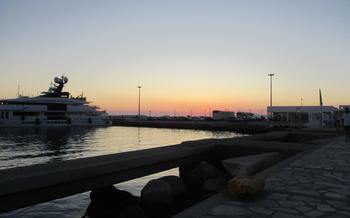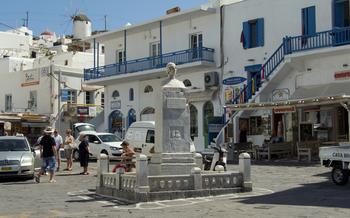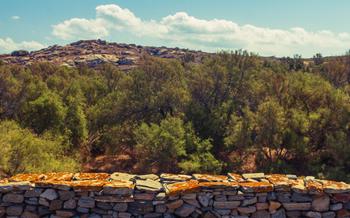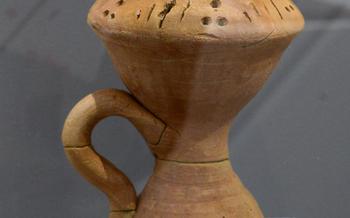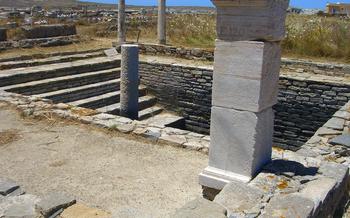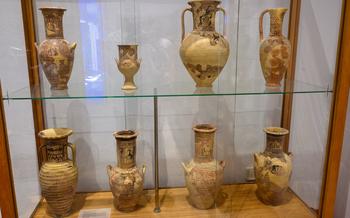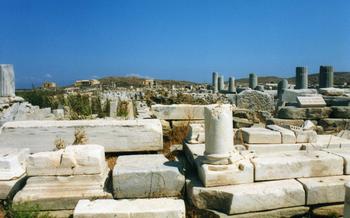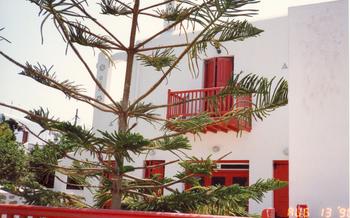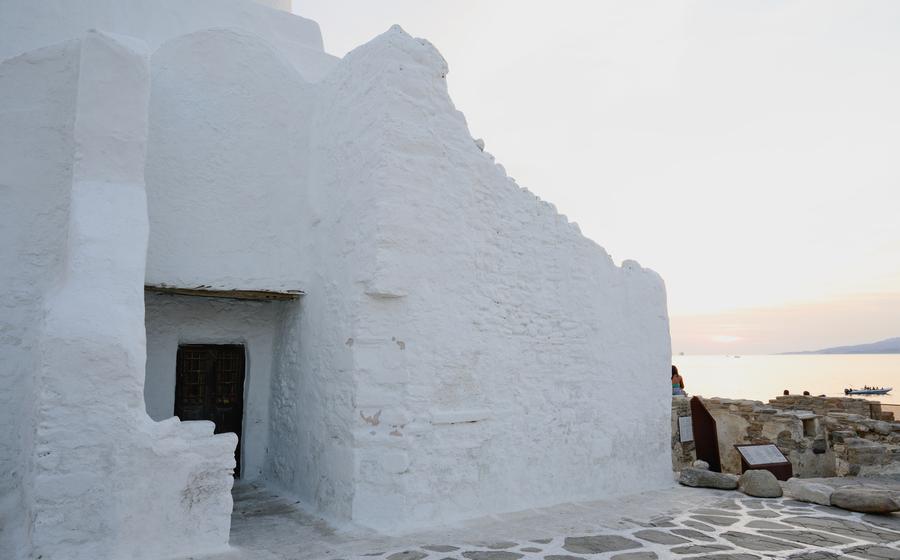
Mykonos Castle (Kastro)
- The Mykonos Castle (Kastro), a Historical Marvel
- Exploring the Enchanting Streets
- The Church of Panagia Paraportiani: A Symbol of Divine Grace
- The Mykonos Windmills
- Mykonos Beaches, a Paradise for Sunseekers
- The Archaeological Museum of Mykonos: A Journey Through the Past
- The Folklore Museum of Mykonos: A Glimpse into the Past
- The Mykonos Art Galleries
- Dining in Mykonos, a Culinary Delight
The Mykonos Castle (Kastro), a Historical Marvel
Perched atop a hill overlooking the Aegean Sea, the Mykonos Castle (Kastro) stands as a testament to the island's rich history. Built in the 13th century by the Venetians to protect against pirate attacks, the castle served as a defensive fortress for centuries. Its thick walls and strategic location made it an impenetrable stronghold, ensuring the safety of the island's inhabitants.
The castle's architectural features reflect its defensive purpose. Its massive ramparts, reinforced by numerous towers, provided a strong barrier against invaders. The narrow, winding streets within the castle walls allowed for easy maneuverability and rapid deployment of troops. The castle's design also incorporated several secret passages and hidden chambers, serving as escape routes and storage spaces during times of siege.
As a symbol of Mykonos' rich history, the castle stands as a reminder of the island's resilience and determination in the face of adversity. Having withstood numerous attacks and occupations throughout the centuries, the castle remains a proud symbol of Mykonos' unwavering spirit. Today, it serves as a popular tourist attraction, offering visitors a glimpse into the island's storied past.
Exploring the Enchanting Streets
Mykonos Castle (Kastro) is surrounded by a maze of cobbled streets that exude a unique charm. These narrow alleys, lined with traditional whitewashed houses and shops, create a picturesque scene that is quintessentially Mykonos. The streets are a delight to explore, with hidden corners and surprises around every turn.
Strolling through these charming streets, visitors can immerse themselves in the local culture and atmosphere. The whitewashed buildings, adorned with colorful bougainvillea flowers, create a vibrant and inviting backdrop. Traditional shops selling handmade crafts, souvenirs, and local delicacies line the streets, offering a glimpse into the island's unique heritage.
The streets are also home to numerous restaurants, bars, and cafes, each with its own distinct character. From cozy tavernas serving traditional Greek cuisine to trendy cafes with outdoor seating, there is something to suit every taste. The lively atmosphere, with locals and tourists alike enjoying the vibrant energy, adds to the charm of these enchanting streets.
Getting lost in the labyrinthine alleys of Mykonos Castle (Kastro) is a delightful experience. Visitors can wander aimlessly, discovering hidden gems and capturing the essence of this enchanting neighborhood. Whether it's a quiet corner for a romantic stroll or a bustling street with lively bars and restaurants, these streets offer a unique and unforgettable experience for every traveler.
The Church of Panagia Paraportiani: A Symbol of Divine Grace
Nestled amidst the whitewashed labyrinth of Mykonos Town, the Church of Panagia Paraportiani stands as an architectural masterpiece and a symbol of the island's rich history. This unique edifice, with its dazzling white exterior and intricate domed roofs, is a fusion of Byzantine and Cycladic styles, reflecting the island's cultural heritage.
Built in the 15th century, the Church of Panagia Paraportiani, meaning "Our Lady of the Side Door," has become an iconic landmark of Mykonos. Its unusual design, featuring five distinct chapels merged into a single structure, is believed to have been influenced by the island's limited space and the need to accommodate multiple religious communities.
The church's interior is adorned with beautiful frescoes and intricate iconography, depicting scenes from the life of Christ and the Virgin Mary. The church's simplicity and elegance, combined with its historical significance, make it a popular destination for pilgrims, art enthusiasts, and visitors seeking a glimpse into Mykonos' spiritual and cultural heritage.
The Mykonos Windmills
The Mykonos windmills are one of the island's most iconic landmarks. These majestic structures, standing tall on a hilltop overlooking the town, are a symbol of Mykonos' rich history and cultural heritage. Originally constructed in the 16th century by the Venetians, these windmills were used to grind grain and produce flour. Their unique design, with their cylindrical stone towers and thatched roofs, has become synonymous with the island.
Today, the windmills stand as a testament to Mykonos' past. They have been carefully restored and preserved, and some have been converted into museums or shops, offering visitors a glimpse into the island's milling traditions. Climbing up to the windmills is a must-do for any visitor to Mykonos. The panoramic views from the hilltop are breathtaking, offering stunning vistas of the town, the harbor, and the Aegean Sea.
The windmills are particularly captivating at sunset when the sky turns a myriad of colors, casting a warm glow on the whitewashed buildings and the windmills. It's a magical moment that captures the essence of Mykonos, a place where history, beauty, and tradition intertwine.
Mykonos Beaches, a Paradise for Sunseekers
Mykonos is blessed with an array of pristine beaches, each offering a unique experience to sunseekers and beach lovers. The island's most famous beaches, such as Paradise, Super Paradise, and Elia, are renowned for their crystal-clear waters, golden sands, and lively atmosphere. These beaches are perfect for those who enjoy swimming, sunbathing, and indulging in water sports activities like jet skiing, windsurfing, and parasailing.
For those seeking a more tranquil beach experience, Mykonos also offers secluded coves and hidden gems. Agios Sostis and Ftelia are two such beaches, where visitors can escape the crowds and enjoy the serenity of the natural surroundings. These beaches are ideal for swimming, snorkeling, and simply relaxing in the sun.
No matter what your preference, Mykonos has a beach to suit every taste. Whether you're looking for a lively party atmosphere or a peaceful retreat, you're sure to find your perfect beach paradise on this enchanting island.
The Archaeological Museum of Mykonos: A Journey Through the Past
Nestled in the heart of Mykonos Town, the Archaeological Museum stands as a testament to the island's rich history and cultural heritage. Within its walls, a treasure trove of artifacts from Mykonos and the neighboring sacred island of Delos awaits eager explorers.
As you step into the museum, you are greeted by an array of sculptures, pottery, jewelry, and other relics that narrate the story of ancient Greece. Discover intricate marble statues that once adorned temples and sanctuaries, delicate pottery vessels that held the secrets of everyday life, and exquisite jewelry that showcased the artistry of ancient craftsmen.
Each artifact whispers tales of a bygone era, offering insights into the lives, beliefs, and customs of the ancient Greeks. Learn about the religious rituals performed in the temples of Delos, the bustling trade that connected Mykonos to distant shores, and the everyday objects that shaped the lives of ordinary people.
The Archaeological Museum of Mykonos is not just a repository of ancient treasures; it is a gateway to the past, inviting visitors to embark on a journey through time and immerse themselves in the rich cultural tapestry of ancient Greece.
The Folklore Museum of Mykonos: A Glimpse into the Past
Nestled in the heart of Mykonos Town, the Folklore Museum offers a fascinating journey into the island's rich cultural heritage. Housed in a traditional Mykonian building, the museum showcases a collection of artifacts that provide a glimpse into the daily lives and traditions of the island's inhabitants.
From traditional costumes and textiles to agricultural tools and household items, the museum's exhibits offer a tangible connection to Mykonos' past. Visitors can admire intricate embroideries, colorful woven rugs, and handcrafted ceramics that showcase the island's artistic traditions.
The museum also houses a collection of photographs, documents, and personal belongings that shed light on the social and economic history of Mykonos. Through these artifacts, visitors can learn about the island's maritime heritage, its agricultural practices, and the customs and beliefs of its people.
A visit to the Folklore Museum of Mykonos is an enriching experience that allows visitors to connect with the island's soul and gain a deeper understanding of its unique culture and traditions. It is a must-visit for anyone interested in exploring the authentic side of Mykonos.
The Mykonos Art Galleries
Mykonos is not only a paradise for sunseekers and history buffs but also a haven for art enthusiasts. The island boasts a vibrant art scene with numerous contemporary and traditional galleries showcasing the works of local and international artists. From modern paintings and sculptures to traditional Greek handicrafts, the art galleries in Mykonos offer a diverse range of styles and mediums to explore.
Strolling through the charming streets of Mykonos Town, visitors will come across a variety of art galleries, each with its own unique charm and collection. Some galleries focus on the works of emerging local artists, while others showcase the masterpieces of established international artists. Visitors can discover abstract paintings, intricate sculptures, vibrant ceramics, and delicate jewelry, all inspired by the beauty and culture of Mykonos.
Whether you are an art connoisseur or simply appreciate beautiful things, the Mykonos art galleries are a must-visit. Take your time to explore the different exhibitions, engage in conversations with the gallery owners and artists, and perhaps even find a unique piece of art to take home as a souvenir of your time in Mykonos.
Dining in Mykonos, a Culinary Delight
Mykonos is a foodie's paradise, offering a diverse culinary scene that tantalizes the taste buds. Fresh seafood, caught daily from the crystal-clear Aegean Sea, takes center stage on many menus. Indulge in grilled octopus, succulent lobsters, or flavorful shrimp saganaki, a traditional dish simmered in a rich tomato sauce.
For a taste of authentic Mykonian cuisine, venture into the charming tavernas that dot the island. These family-run establishments serve up hearty dishes that have been passed down through generations. Sample the delicious moussaka, a layered eggplant and potato casserole, or try the savory pastitsio, a baked pasta dish with minced meat and béchamel sauce.
Fine-dining experiences await those seeking an elevated culinary journey. Michelin-starred restaurants perched on the waterfront offer panoramic views of the sea, creating an unforgettable ambiance for a special evening. Savor innovative dishes that showcase the finest local ingredients, artfully prepared by talented chefs.
Whether you prefer a casual meal by the beach, a romantic dinner in a charming taverna, or a gastronomic extravaganza at a fine-dining establishment, Mykonos has something to satisfy every palate. Embark on a culinary adventure and discover the delectable flavors of this enchanting island.
